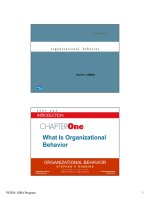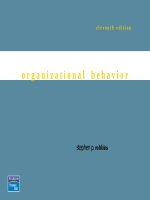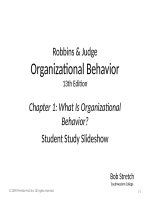Chapter 1 what is money
Bạn đang xem bản rút gọn của tài liệu. Xem và tải ngay bản đầy đủ của tài liệu tại đây (4.44 MB, 9 trang )
Required Chapters
•
•
•
•
•
•
•
•
•
•
•
3-1
1) Why study Money, Banking and FMs?
2) An overview of the Financial System
3) What is Money?
4) Understanding the interest rates
5) The behavior of interest rate
6) Risk and Term structure of Interest rate
8) An Economic Analysis of Financial Structure
10) Banking & Management of FIs
13) Central Banks & Federal Reserve System
15) The tools of Monetary Policy
17) The Foreign Exchange Market
Chapter 1
Overview of
Finance and
Money
© 2013 Pearson Education, Inc. All rights reserved.
What is Finance?
• “The study of how individuals, institutions,
governments and businesses acquire,
spend, and manage money and other
financial assets” (Melicher & Norton, 2013)
• Finance is the study of concepts,
applications, and systems that affect the
value (or wealth) of individuals, companies,
and countries over the short and long term
(Erik Banks, 2015)
3-3
© 2013 Pearson Education, Inc. All rights reserved.
Meaning of Finance
• The study of how money is managed and
the actual process of acquiring needed
funds.
• Individuals, business & government entities
need funding to operate
• à Personal finance, corporate finance &
public finance
3-4
Public Finance
• The study of the income and expenditure of
the Government.
• the collection of funds and their allocation
between various branches of state activities
3-5
© 2013 Pearson Education, Inc. All rights reserved.
â 2013 Pearson Education, Inc. All rights reserved.
Corporate Finance
ã The financial activities related to running
corporation
ã Goal: Maximing shareholder value
3-6
â 2013 Pearson Education, Inc. All rights reserved.
Personal Finance
Goals of finance
• Apply principles of finance to the monetary
decisions of an individual or family unit
• Obtain, budget, save and spend monetary
resources over time, taking into account
various financial risk and future life events.
• To maximize the value of operation.
• To manage liquidity and solvency
– Liquidity: a sufficiency of cash (or assets that
can be quickly converted to cash) to pay bills
and cover any surprises or emergencies (“thanh
khoản”)
– Solvency: a sufficiency of capital to meet
unexpected losses (“thanh tốn”)
• To manage risk: operating risk, financial
risk, legal risk, environmental risk
3-7
ã
â 2013 Pearson Education, Inc. All rights reserved.
3-8
Khái niệm tiền tệ
Meaning of Money
What is
money?
Money
Stock
Bond
Commodities
gold
Land
Real estate
3-9
â 2013 Pearson Education, Inc. All rights reserved.
9
ã What is it?
• Money (or the “money supply”): anything
that is generally accepted in payment for
goods or services or in the repayment of
debts.
3-10
Meaning of Money (cont’d)
• Money (a stock concept) is different from:
• Wealth: the total collection of pieces of
property that serve to store value (e.g.
stocks, bonds, lands)
• Income: flow of earnings per unit of time
(a flow concept).
3-11
© 2013 Pearson Education, Inc. All rights reserved.
© 2013 Pearson Education, Inc. All rights reserved.
© 2013 Pearson Education, Inc. All rights reserved.
The Evolution of Money
If money did not exist, what
would the world be like?
-> Barter Economy-moneyless
economy that relies on trade or
barter
3-12
© 2013 Pearson Education, Inc. All rights reserved.
Early Money
Money in Primitive Societies
• Early Societies developed forms of protomoney which were commodities that
everyone agreed to accept in trade
• Examples:
Aztecs-Cacao Beans (aka cocoa beans)
Norwegians-Butter
Colonists- Tobacco leaves, animal hides
China, India, Thailand, and West Africa-Cowrie
shells
3-13
© 2013 Pearson Education, Inc. All rights reserved.
Commodity Money- money that has an
alternative use as an economic good, or
commodity
Fiat Money- money by governmental decree
3-14
Money in Colonial America
• Both fiat money and
commodity money were
used in the original
thirteen colonies.
– Commodity money in
America was used to settle
debts, make purchases, or
for personal consumption
– In Massachusetts the local
government gave wampum
shells a monetary value
3-15
â 2013 Pearson Education, Inc. All rights reserved.
Early Paper Currency
ã Early paper money was backed
by gold or silver deposits,
served as currency for
immediate area
• States printed money in form
of tax anticipation notes which
were used to pay salaries, buy
supplies and meet other
expenditures until they
received taxes and redeemed
the notes
• 1775 Continental Congress
printed money that was not
backed by gold or silver
• Issues??
3-16
Specie in the Colonies
Specie- money in the form of gold or silver
coins
• Most desirable form of money because of
mineral content, and limited supply
• 1776 there was $12million dollars worth of
coin vs. $ 500 million in paper money
© 2013 Pearson Education, Inc. All rights reserved.
© 2013 Pearson Education, Inc. All rights reserved.
The Characteristics of Money
Portability- can be easily transferred from one person to
another, and makes the exchange of money for products easier
Durable- does not deteriorate when handled and can be easily
replaced
Divisible- should be able to be broken down into smaller units so
that people can use only as much as needed for a transaction
Limited Supply- can not have to much of something because
then it becomes worthless
3-17
© 2013 Pearson Education, Inc. All rights reserved.
3-18
© 2013 Pearson Education, Inc. All rights reserved.
Which of these items meet
the four characteristics of
money?
So does our money meet all the
necessary requirements?
• Portabilitylight weight, convenient, easily transferable
• DurableCoins tend to last over 20 years, and paper
currency lasts 18 months in circulation before
being replaced
• DivisiblePenny is small enough for almost all purchases,
and can write checks for exact amounts
• Limited Supply/StabilityFluctuates, grew at a rate of 10-12 percent a
year in 1970’s, but for the most part there is a
stable and limited supply
3-19
© 2013 Pearson Education, Inc. All rights reserved.
3-20
Functions of Money
© 2013 Pearson Education, Inc. All rights reserved.
Functions of Money
• a medium of exchange:
– When any good or service is purchased, people
use money
– Money makes it easier to buy and sell because
money is universally accepted
– Money, then, provides us with a shortcut in
doing business
• By acting as a medium of exchange, money
performs its most important function
3-21
© 2013 Pearson Education, Inc. All rights reserved.
3-22
Example: Money as a medium of exchange
Functions of Money
An example of a barter economy
• A Medium of Exchange:
– Eliminates the trouble of finding a double
coincidence of needs (reduces transaction costs)
– Promotes specialization
• A medium of exchange must
–
–
–
–
–
3-23
be easily standardized
be widely accepted
be divisible
be easy to carry
not deteriorate quickly
© 2013 Pearson Education, Inc. All rights reserved.
13-5
© 2013 Pearson Education, Inc. All rights reserved.
Copyright ©2002 by The McGraw-Hill Companies, Inc. All rights reserved.
3-24
Individual A
Individual C
Offers
bread
Offers
bananas
Demands
soda
Demands
bread
Individual B
Individual D
Offers
soda
Offers
bananas
Demands
bananas
Demands
education
© 2013 Pearson Education, Inc. All rights reserved.
Trade in this barter economy only
takes place, if individual A decides
to trade its bread against
individual C’s bananas, which in
turn A can exchange against B’s
bananas.
Individual D cannot trade in this
economy since within this group
nobody is offering anything D
wants. D, however, potentially has
bananas to offer, which remain
unused.
24
Money As a Medium of Exchange
Functions of Money (cont’d)
• Unit of Account (Measure/ Standard of
Value)
• Money does not have to have any inherent
value to function as a medium of
exchange.
– Used to measure value in the economy
– Without money, we would have to measure the
value of goods and services in terms of other
goods and services.
– reduces transaction costs
• All that is necessary is that everyone believes
that other people will exchange it for their
goods.
3-25
© 2013 Pearson Education, Inc. All rights reserved.
3-26
Functions of Money (cont’d)
Store of Value
• Unit of Account
• Store of Value:
No. of
No. of prices in nonProducts = monetary economy
n
= n(n-1)/2
3-27
© 2013 Pearson Education, Inc. All rights reserved.
– used to save purchasing power over time.
– other assets also serve this function
– Money is the most liquid of all assets but
loses value during inflation
• Money is a financial asset that can be used to
store wealth (income that you have saved and
not consumed).
• As a store of wealth, money pays no interest,
but is perfectly liquid.
• Money’s usefulness as a store of wealth
depends on how will it maintains its value.
No.of prices in a
monetary
economy = n
3
3
3
10
45
10
100
4.950
100
1.000
499.500
1.000
10.000
49.995.000
10.000
© 2013 Pearson Education, Inc. All rights reserved.
3-28
© 2013 Pearson Education, Inc. All rights reserved.
Copyright ©2002 by The McGraw-Hill Companies, Inc. All rights reserved.
13-7
Standard of Deferred Payment
Store of Value
• If you could buy 100 units of goods and
services with $100 in 1982, how many
units could you buy with $100 in 2010?
• Many contracts promise to pay fixed
sums of money well into the future
– A couple of examples are 30-year corporate
bonds and a 20-year mortgage
– Answer: you could have bought <50 units
– During this period, inflation robbed the dollar
of almost half of its purchasing power
• Over the long run, particularly since
World War II, money has been a very
poor store of value
– However, over relatively short periods of
time, say, a few weeks or months, money
does not lose much of its value
3-29
© 2013 Pearson Education, Inc. All rights reserved.
13-7
3-30
© 2013 Pearson Education, Inc. All rights reserved.
Copyright ©2002 by The McGraw-Hill Companies, Inc. All rights reserved.
13-8
Evolution of the Payments System
Commodity money
• Payment system:
Method of conducting transactions in the economy.
• Means of payment:
1. Commodity Money
2. Fiat Money
3. Checks
4. Electronic means of payment
5. Electronic money
– Commodity money is a means of payment made out of
precious metals such as gold or silver or other valuable
commodities.
– It has been the prevailing medium of exchange in most
societies since classical times up to around two hundred
years ago.
Roman circus coin (Hadrianus)
3-31
© 2013 Pearson Education, Inc. All rights reserved.
3-32
Commodity money
1. It’s value is not necessarily easily to prove for everyone.
Problems of forgery or debasing have been common in
history.
2. Commodity money is generally heavy and hard to
transport.
3. The value of commodity money varies with the value of
the underlying commodity and, therefore, is subject to
fluctuations of supply and demands for these goods.
33
© 2013 Pearson Education, Inc. All rights reserved.
3-34
© 2013 Pearson Education, Inc. All rights reserved.
Electronic payment
– Checks are an instruction to a bank to transfer money from
one person’s account to the bank account of the recipient once
he or she deposits the check.
– Checks, thus, solve the problem of transport for large
amounts of money and facilitate transactions in a number of
other ways.
– However, two problems arise with the use of checks:
• Moving checks from one point to another takes time
• The processing of checks does not come for free and imposes a
transaction cost by itself to society
© 2013 Pearson Education, Inc. All rights reserved.
32
qThe development of bank notes – originally backed
by a convertibility guarantee – succeeded
commodity money.
q Paper money quickly converted into fiat money:
money issued by governments as legal tender, but
without any right of convertibility
Checks
3-35
© 2013 Pearson Education, Inc. All rights reserved.
Fiat Money
Commodity money fulfills the criterion of general acceptance,
because it consists of materials which are already high in
demand.
It comes with a number of problems, however:
3-33
1878 Brasher doubloon
35
qIncreasingly common forms of means of transaction
are electronic payment services offered online by
banks.
qInstead of mailing out a check for every single
payment, you simply log on to the bank’s web site or
have your money automatically deducted on a
regular basis
qElectronic payment is a very common means of
transaction in many countries.
3-36
© 2013 Pearson Education, Inc. All rights reserved.
36
THE FUTURE OF MONEY
E-Money
Question: Which function of money will be
with us for a long time?
Answer:
Not only checks get increasingly substituted by
electronic forms of payment, cash has also been partly
replaced by other instruments
– Means of payment: disappearing
– Unit of account: likely to remain
– Store of value: disappearing
Common forms of E-money include
q Debit and credit cards
q Money cards or “smart” cards
q E-cash
3-37
© 2013 Pearson Education, Inc. All rights reserved.
37
3-38
TECHNOLOGICAL ADVANCES AND
PAYMENT METHODS
FYI Are We Headed for a Cashless
Society?
• Predictions of a cashless society have been
around for decades, but they have not come
to fruition
• Although e-money might be more
convenient and efficient than a payments
system based on paper, several factors
work against the disappearance of the paper
system
• Still, the use of e-money will likely still
increase in the future
3-39
â 2013 Pearson Education, Inc. All rights reserved.
ã Technological advances create new methods
of payment.
• Cell phones and other types of hand-held
mobile devices are providing access to the
payments system.
• What will be next?
3-40
qWe defined money as anything generally accepted
in payment for goods and services
qSince many commodities have had this function in
history, we need a closer definition of money to
measure the actual stock of money in an economy at
a specific point in time
© 2013 Pearson Education, Inc. All rights reserved.
© 2013 Pearson Education, Inc. All rights reserved.
Measuring Money
Measuring money
3-41
© 2013 Pearson Education, Inc. All rights reserved.
41
• Changes in the quantity of money are
related to
– Interest Rates
– Economic Growth
– Inflation
• How do we measure money? Which
particular assets can be called “money”?
• Construct monetary aggregates using the
concept of liquidity
3-42
© 2013 Pearson Education, Inc. All rights reserved.
DEFINITION OF LIQUIDITY
THE LIQUIDITY SPECTRUM
Liquidity: a measure of the ease an asset
can be turned into a means of payment
(Money).
3-43
© 2013 Pearson Education, Inc. All rights reserved.
3-44
Measuring Money (Different
Definitions for the Money Supply)
© 2013 Pearson Education, Inc. All rights reserved.
Table 1 Measures of the
Monetary Aggregates
• M1- component of the money
supply relating to money’s role
as a medium of exchange
– Currency (Coins and Paper Money)
– All checkable deposits (travelers
checks, checking account)
• M2- component of the money
supply relating to money’s role
as a store of value
– Savings (savings deposit & money
market deposit account)
– Small time deposits (6 mo. CD)
– Money market funds (mutual
fund)
3-45
© 2013 Pearson Education, Inc. All rights reserved.
3-46
KHỐI TIỀN (tt)
Monetary Aggregates
M1 (4)
© 2013 Pearson Education, Inc. All rights reserved.
M2 (4+3)
Currency
Traveler’s Checks
Demand Deposits
Other Check. Dep
Small Den. Dep.
Savings and MM
Money Market Mutual
Funds Shares
M3 (4+3+4)
3-47
© 2013 Pearson Education, Inc. All rights reserved.
3-48
© 2013 Pearson Education, Inc. All rights reserved.
Figure 1 Growth Rates of the M1 and
M2 Aggregates, 1960–2011
M1 vs. M2
• Does it matter which measure of money is
considered?
• M1 and M2 can move in different directions
in the short run (see figure).
• Conclusion: the choice of monetary
aggregate is important for policymakers.
Sources: Federal Reserve Economic Database (FRED); Federal Reserve Bank of Saint Louis;
/>3-49
© 2013 Pearson Education, Inc. All rights reserved.
3-50
© 2013 Pearson Education, Inc. All rights reserved.









